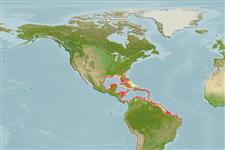Common names from other countries
Environment: milieu / climate zone / depth range / distribution range
Ecologia
marinhas associadas(os) a recifes; intervalo de profundidade 3 - 50 m (Ref. 9626). Subtropical; 34°N - 12°S, 99°W - 32°W
Western Atlantic: Bermuda, southeastern Florida (USA), and the Bahamas to Brazil.
Length at first maturity / Tamanho / Peso / Idade
Maturity: Lm 19.0 range ? - ? cm
Max length : 33.0 cm TL macho/indeterminado; (Ref. 7251); common length : 25.0 cm TL macho/indeterminado; (Ref. 3798); peso máx. Publicado: 550.00 g (Ref. 5217)
Espinhos dorsais (total) : 12; Raios dorsais moles (total) : 15 - 17; Raios anais moles: 8. Broad black area above line from dorsal fin origin to tip of lower caudal fin lobe, including upper part of caudal peduncle and both lobes of tail. Striking colored species, with a silvery body, black back and tail (Ref. 26938). With narrow yellow stripes, the broadest mid-lateral (Ref. 13442).
Inhabits clear inshore and offshore reefs (Ref. 9710) and adjacent grass beds, often in schools (Ref. 3798). Feeds on crustaceans (Ref. 3798). Marketed fresh (Ref. 3798).
Oviparous, distinct pairing during breeding (Ref. 205).
Robins, C.R. and G.C. Ray, 1986. A field guide to Atlantic coast fishes of North America. Houghton Mifflin Company, Boston, U.S.A. 354 p. (Ref. 7251)
Categoria na Lista Vermelha da IUCN (Ref. 130435)
CITES (Ref. 128078)
Not Evaluated
Ameaça para o homem
Reports of ciguatera poisoning (Ref. 30303)
Utilização humana
Pescarias: pouco comercial; Aquário: Aquários públicos
Ferramentas
Relatórios especiais
Descarregue XML
Fontes da internet
Estimates based on models
Preferred temperature (Ref.
115969): 23.7 - 28, mean 26.8 (based on 288 cells).
Phylogenetic diversity index (Ref.
82804): PD
50 = 0.5000 [Uniqueness, from 0.5 = low to 2.0 = high].
Bayesian length-weight: a=0.01778 (0.01068 - 0.02961), b=2.99 (2.85 - 3.13), in cm Total Length, based on LWR estimates for this species & Genus-body shape (Ref.
93245).
Nível Trófico (Ref.
69278): 2.2 ±0.1 se; based on diet studies.
Resiliência (Ref.
120179): Médio, tempo mínimo de duplicação da população 1,4 - 4,4 anos (K=0.3).
Fishing Vulnerability (Ref.
59153): Low to moderate vulnerability (33 of 100).
